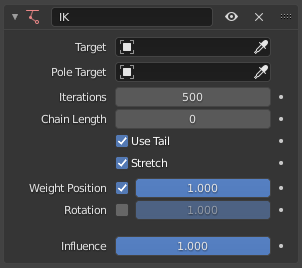Inverse Kinematics Constraint
The Inverse Kinematics constraint implements the inverse kinematics armature posing technique. Hence, it is only available for bones. To quickly create an IK constraint with a target, select a bone in Pose Mode, and press Shift-I.
This constraint is fully documented in the Inverse Kinematics page, part of the rigging chapter.
Nota
The IK constraints are special in that they modify multiple bones. For this reason, they ignore their position in the stack and always run after all other constraints on the affected bones. To apply constraints after IK, it is necessary to first copy the final transformation to a new bone chain, e.g. using Copy Transforms.
Opzioni

Inverse Kinematics panel.
- Target
ID used to select the an armature. See common constraint properties for more information.
- Pole Target
Object for pole rotation.
- Iterations
Maximum number of solving iterations.
- Chain Length
How many bones are included in the IK effect. Set to 0 to include all bones.
- Use Tail
Include bone’s tail as last element in chain.
- Stretch
Enable IK stretching.
- Weight Position
For Tree-IK: Weight of position control for this target.
- Rotazione
Chain follows rotation of target.
- Target
Disable for targetless IK.
- Influenza
Controls the percentage of affect the constraint has on the object. See common constraint properties for more information.
iTaSC Solver
If the iTaSC IK Solver is used, the IK Solver Constraint changes to add these addition parameters.
- IK Type
- Copy Pose
Equivalent to the traditional end effector position and orientation constraint: the end effector is constrained to take the position, and optionally the orientation, of a given target, which is set in the target field.
- Position/Rotation Locking
Allows to obtain various effect by not constraining the coordinates along certain axis.
- Axis Reference
Specifies how to compute the axis coordinates.
- Osso
The coordinates are the position and orientation of the target relative to the bone.
- Target
The opposite of Bone, the coordinates are the position and orientation of the tip of the bone relative to the target.
- Distance
Specify that the end effector will stay inside, at, or outside a sphere centered on the target object.
- Limit Mode
- Inside
The end effector will stay inside of the distance from the target object.
- Outside
The end effector will stay outside of the distance from the target object.
- On Surface
The end effector will stay exactly at the distance from the target object.
- Distance
The radius from the target object.
Nota
The Influence parameter is not implemented if Pole Target is used.